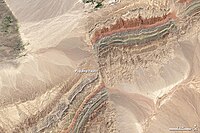
Photo from wikipedia
Abstract The South China, Heyuan Fault Zone provides unique crustal exposure to study the meso- macroscale architecture of evolving fracture networks in response to a change in tectonic stress regime… Click to show full abstract
Abstract The South China, Heyuan Fault Zone provides unique crustal exposure to study the meso- macroscale architecture of evolving fracture networks in response to a change in tectonic stress regime and associated changing fluid flow pathways. Multiple generations of fracturing across the fault zone reveal its structural evolution related to the change in stress regime from extensional (since the Mesozoic) to transpressive (in the Cenozoic), which coincides with generations of growth and fracturing on the microscale. Low angle, mode-I fractures, quartz veining, and a giant quartz reef (>75 m wide and 40 km long) were formed due to a combination of chemo-mechanical mechanisms, including a crucial phyllonite ‘cap rock’, during the extensional phase. This evolved through to a predominately sub-vertically aligned, shear fracture network, exhibiting only minor quartz precipitation. These open fractures are attributed to the transpressive regime experienced since the Cenozoic, in which strike-slip faults cross-cut the Heyuan Fault. We propose that this sub-vertical fracture network provides the fluid flow pathway supplying the present-day hot springs by penetrating through the phyllonite seal, which previously enabled SiO2 accumulation. Additionally, further quartz-reef building would likely be reduced due to (i) lack of seal integrity, and (ii) an unfavourable tectonic setting to channel the flow and provide accommodation space.
Journal Title: Tectonophysics
Year Published: 2020
Link to full text (if available)
Share on Social Media: Sign Up to like & get
recommendations!